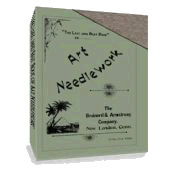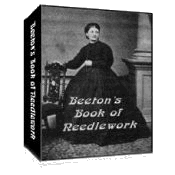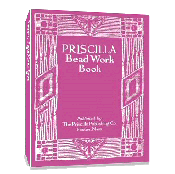[]Subscribe To This Site
All About the Tapestry Stitch
The Tapestry Stitch, like many other embroidery stitches of the Victorian era, was a stitch that had one name but was embroidered two completely different ways. Method 1 is most often found when this stitch was referred to.

Click on picture to see more detail.
This stitch is an adaptation of the Long and Short Stitch for backgrounds. It makes a solid filling and is the most beautiful of all the background stitches. It is used in flower stems and the article entitled “How to Embroider Flower Stems” should be read in this connection. The lines in this work are kept exactly parallel, never converging or diverging and there is usually no shading. The stitches lap, just as they do in the Solid Kensington work, and the finished background presents a perfectly smooth, even surface. As many repeats of the Long and Short Stitch must be worked as are necessary to fill the space, and in order to give a rich effect, the stitches must be well lapped. The shading in the illustration is done simply to show the repeats of the Long and short Stitch (See Figure No. 1).
In order to be bounded by lines these rows terminate squarely where they come in contact wit the outlines. This embroidery is more conventional than feather stitch; therefore it is better suited to conventional forms and backgrounds.

Click on picture to see more detail.
The superb figure work of the sixteenth century is tapestry stitch embroidery. Backgrounds are usually thus embroidered, especially those on ecclesiastical vestments and hangings. Figure No. 2 another illustration that shows the method as applied to a background. The effect from a little distance is that of a smooth surface; at a close range the perfectly laid stitches should be apparent. The work in background is usually one color; but shading by this means is possible. The different colors in the illustration are introduced only in order to show the method more adequately. When curved figures are to be covered with this stitch a peculiar difficulty arises, the solution of which results in producing the distinctly different long and short method already described as “overlap stitch” on a curved space, and which from its relation to both the “overlap stitch” and the tapestry, we may call “overlap tapestry stitch.
Tapestry Stitch – Method No. 2

It is in this stitch that the old hangings and pictures, no so valued from their antiquity, were made. Although very simple, only those having some knowledge of the art of painting should attempt anything in this stitch, as the shading must depend upon the eye and not upon a counting of the stitches. Many of the old designs were painted upon the foundation canvas, which was of great assistance to the worker; and we presume that some of the decorative art societies who are making a revival of Gobelin tapestry a specialty, will be able to furnish the same style of design. An artist in tapestry work can copy accurately from an oil-painted picture, with only the eye directing the coloring and shading. As we have before mentioned, four threads of canvas – two each way- mark out the space for one ordinary cross-stitch, and in this space two tapestry stitches are made. They are worked from left to right, crossing four threads one height and one in width with a back-stitch movement, bringing the needle out toward the worker at the bottom of the line upon which she is working. Figure No. 3 illustrates clearly the effect and the method of making tapestry stitch.
Return to top of Tapestry Stitch page.
Return to Embroidery Stitches page.
Return to Home page.



 433 pages!
433 pages!

